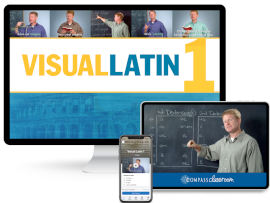Visual Latin is a challenging, grammatically-based Latin program suitable for upper-elementary, middle, and high school students. Lessons are presented on videos via DVDs or downloads. There are two Visual Latin courses: Visual Latin I and Visual Latin II.
They can be used as stand-alone, one-year courses that introduce students to Latin. Both courses have their own teacher's guide and student book with worksheets and quizzes. The books are available as free PDFs or as printed books that you can purchase. Using just these components will work with students below high school level, but you can create a program for a two-year high school course by supplementing with the Latin reader Lingua Latina: Pars I: Familia Romana (just the reader). A free downloadable document has a chart showing when students should read which chapters in Lingua Latina.
The video lessons are the highlight of these courses. Presenter Dwane Thomas uses lots of humor in his presentations which I expect most students will find engaging, even the corny jokes. Thomas uses ecclesiastical pronunciation instead of classical and provides a video explaining how this pronunciation works. Each course has 30 lessons, and each lesson has three short videos. The three videos for each lesson are titled “Grammar,” “Sentences,” and “Reading,” respectively. However, actual distinctions between the content are a bit fuzzy—and it doesn't really matter. Students complete a worksheet after each video. Along with the worksheets, the student files include quizzes, vocabulary sheets, and reference charts. (The teacher has PDFs for the teacher's guide and the answer keys for the worksheets and quizzes.)
High school students should spend about five hours per week on these courses. They will add reading from Lingua Latina after Lesson 16 in Visual Latin I. Lingua Latina is written entirely in Latin, so about halfway through the first Visual Latin course, students should have sufficient knowledge of Latin grammar and vocabulary to comfortably start the reader.
Suggested schedules in the teacher's guides recommend that students re-watch the video segments at least once and also devote time to studying and memorizing content from both Visual Latin and Lingua Latina. Online flashcards are provided through Quizlet. The teacher's guides also recommend listening to the Bible read aloud in Latin, and they provide the URL for a free, online audio Bible in Latin. CompassClassroom.com also has links to other briefer Latin readers that are free online. The teacher's guides show when to use a few of them.
For younger students, you should move at a slower pace through Visual Latin, making sure students understand the grammatical concepts. (This can be a wonderful way to teach or reinforce English grammar at the same time students are learning Latin, but this requires more teacher involvement.) Younger students not using Lingua Latina will spend at least two hours per week.
Some high school students might want to use Visual Latin as a supplement to Henle Latin I to add an audio-visual component to that course (which typically takes two years to complete). Thomas provides a PDF chart showing how to correlate the two resources.
Visual Latin on its own or with Linga Latina doesn't require that the teacher know Latin. Students should be able to complete most of the work independently, and teachers can use the answer keys to check work and quizzes. This works because Visual Latin is not intended to be a conversational approach since Latin is generally read rather than spoken.
You might use the videos and worksheets in a less-pressured way with younger students, skipping the quizzes. For some students, watching the videos a number of times might be a more effective method of learning. However, students serious about learning Latin should spend time reading and studying to master both the grammar and the vocabulary.
Visual Latin has significant Christian content in its reading passages, most of it reflecting the beginning chapters of the book of Genesis.
You can purchase the two courses individually or you can access them online with either a subscription to one course or a Compass Classroom membership that gives you access to many courses. You also have the option of purchasing printed resources and DVDs. You can try out four Visual Latin lessons for free.
Summary
Learning Latin takes hard work, but Dwane Thomas does a great job of making the process more enjoyable. The various course options also help parents tailor the courses to fit their students.











